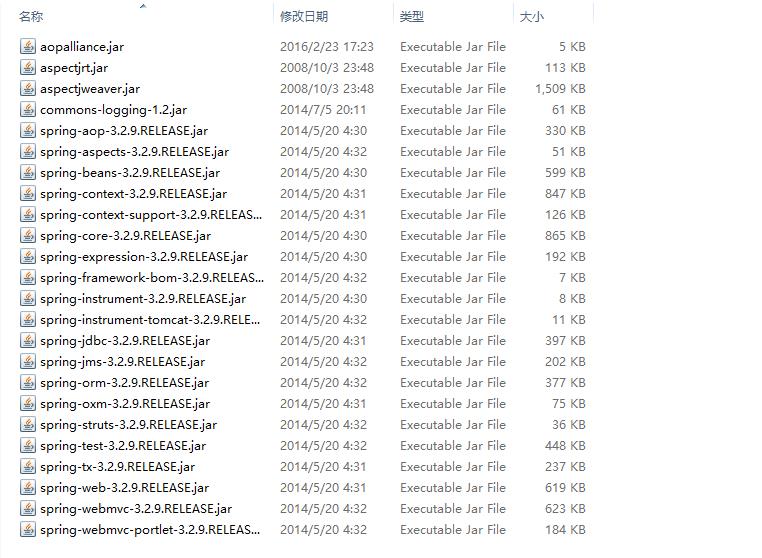Struts2,Spring3,Hibernate4整合--SSH框架(学习中)
一、包的导入
1、Spring包

2、Hibernate 包

3、struts 包 (还欠 struts2-spring-plugin-2.3.28.jar 的包)

4、数据库方面的包及junt4的包

二、配置文件
1、beans.xml (具体要注意的已经注释到 xml 中了,目前整合了Spring 与 hibernate4 )
<?xml version="1.0" encoding="UTF-8"?>
<beans xmlns="http://www.springframework.org/schema/beans"
xmlns:xsi="http://www.w3.org/2001/XMLSchema-instance"
xmlns:context="http://www.springframework.org/schema/context"
xmlns:tx="http://www.springframework.org/schema/tx"
xmlns:aop="http://www.springframework.org/schema/aop"
xsi:schemaLocation="http://www.springframework.org/schema/beans
http://www.springframework.org/schema/beans/spring-beans.xsd
http://www.springframework.org/schema/context
http://www.springframework.org/schema/context/spring-context.xsd
http://www.springframework.org/schema/tx
http://www.springframework.org/schema/tx/spring-tx.xsd
http://www.springframework.org/schema/aop
http://www.springframework.org/schema/aop/spring-aop.xsd">
<!-- 打开Spring 的 Annotation 支持-->
<context:annotation-config/>
<!-- 设定Annotation 到 哪里 找-->
<context:component-scan base-package="org.cs"/>
<!-- 打开Spring 的 Aop 代理 -->
<aop:aspectj-autoproxy/>
<!-- 使用 DBCP 创建 dateSource -->
<bean id="dataSource" class="org.apache.commons.dbcp2.BasicDataSource" destroy-method="close">
<property name="driverClassName" value="${jdbc.driverClassName}" />
<property name="url" value="${jdbc.url}" />
<property name="username" value="${jdbc.username}" />
<property name="password" value="${jdbc.password}" />
<!-- 配置 hibernate -->
<!-- 配置连接池的初始值 为 1-->
<property name="initialSize" value="1"/>
<!-- 配置最小空闲时 -->
<property name="minIdle" value="1"/>
<!-- 最大连接池 -->
<property name="maxTotal" value="100"/>
<!-- 配置最大空闲时-->
<property name="maxIdle" value="20"/>
<!-- 配置等待时间-->
<property name="maxWaitMillis" value="1000" />
</bean>
<context:property-placeholder location="classpath:jdbc.properties"/>
<!-- 整合 hibernate4 创建 SessionFactory 工厂 -->
<bean id="sessionFactory" class="org.springframework.orm.hibernate4.LocalSessionFactoryBean">
<!-- 注入 数据源 -->
<property name="dataSource" ref="dataSource"/>
<!-- 设置 Spring 在哪里找 实体类 -->
<property name="packagesToScan">
<value>org.cs.Model</value>
</property>
<!-- 配置 hibernate -->
<property name="hibernateProperties">
<!--<value>hibernate.dialect=org.hibernate.dialect.HSQLDialect</value>-->
<props>
<prop key="hibernate.dialect">org.hibernate.dialect.MySQLDialect</prop>
<prop key="hibernate.show_sql">true</prop>
<prop key="hibernate.hbm2ddl.auto">update</prop>
<prop key="hibernate.format_sql">false</prop>
</props>
</property>
</bean>
<!-- 配置 Spring 的事务管理 -->
<!-- 创建事务管理器 -->
<bean id="transactionManager"
class="org.springframework.orm.hibernate4.HibernateTransactionManager">
<property name="sessionFactory" ref="sessionFactory"/>
</bean>
<!-- 配置 AOP -->
<aop:config>
<!-- 设置 aop:pointcut 表示 哪些 包.方法 需要加入事务-->
<aop:pointcut id="allMethods"
expression="execution(* org.cs.Service.*.*(..))"/>
<!-- 设置 aop:pointcut 表示 具体 需要加入事物的 方法-->
<aop:advisor advice-ref="txAdvice" pointcut-ref="allMethods"/>
</aop:config>
<!-- 配置那些方法需要加入事务处理 -->
<tx:advice id="txAdvice" transaction-manager="transactionManager">
<tx:attributes>
<!-- 让所有方法加入事务 -->
<tx:method name="*" propagation="REQUIRED" read-only="true"/>
<tx:method name="add*" propagation="REQUIRED"/>
<tx:method name="update*" propagation="REQUIRED"/>
<tx:method name="save*" propagation="REQUIRED"/>
<tx:method name="del*" propagation="REQUIRED"/>
</tx:attributes>
</tx:advice>
</beans>
2、struts.xml (实现 Spring 与 Struts2 的整合 )
<?xml version="1.0" encoding="UTF-8" ?>
<!DOCTYPE struts PUBLIC
"-//Apache Software Foundation//DTD Struts Configuration 2.3//EN"
"http://struts.apache.org/dtds/struts-2.3.dtd">
<struts>
<!-- 设置 url 后缀-->
<constant name="struts.action.extension" value="action,do"/>
<!-- 当 struts的配置文件修改后,系统是否自动重新加载该文件,默认值为false(生 产环境下使用),开发阶段最好打开 -->
<constant name="struts.configuration.xml.reload" value="true"/>
<!-- 表示 Action 由 Spring 依赖注入来注入-->
<constant name="struts.objectFactory" value="org.apache.struts2.spring.StrutsSpringObjectFactory"/>
<!-- xxxAction 使用 struts 配置 -->
<package name="default" namespace="/" extends="struts-default">
<!--<!– 配置拦截器 , 要在 action 配置 后才生效–>-->
<!--<interceptors>-->
<!--<!– 这种 方式 在 action 中需要 配置 defaultStack –>-->
<!--<!–<interceptor name="HelloInterceptor" class="Interceptor.HelloInterceptor"/>–>-->
<!--<!– 这种方式 只需要在 action 中 配置 HelloStack –>-->
<!--<interceptor name="HelloInterceptor" class="Interceptor.HelloInterceptor"/>-->
<!--<interceptor-stack name="HelloStack">-->
<!--<interceptor-ref name="defaultStack"/>-->
<!--<interceptor-ref name="HelloInterceptor"/>-->
<!--</interceptor-stack>-->
<!--</interceptors>-->
<!-- 全局结果集 -->
<global-results>
<result name="error">/WEB-INF/Exception/MyException.jsp</result>
<result name="exception">/WEB-INF/Exception/MyException.jsp</result>
</global-results>
<!-- 异常抛出 配置-->
<global-exception-mappings>
<exception-mapping exception="Exception.MyException" result="exception"></exception-mapping>
</global-exception-mappings>
<!-- 基于 通配符 的 方式 , 由于整合了Spring ,class = "应该是Spring所注入的对象"-->
<action name="*_*" class="{1}Action" method="{2}">
<!-- 拦截器 生效 ,需要有继承 defaultStack -->
<!--<interceptor-ref name="HelloInterceptor"/>-->
<!--<interceptor-ref name="defaultStack"/>-->
<!--<interceptor-ref name="HelloStack"/>-->
<result name="success">/WEB-INF/jsp/{1}/{2}.jsp</result>
<!-- 重定向 type = "redirect" -->
<result type="redirect" name="redirect">/${url}</result>
</action>
</package>
</struts>
3、web.xml (创建 Spring 的 监听器,Struts2 的 过滤器)
<?xml version="1.0" encoding="UTF-8"?>
<web-app xmlns="http://xmlns.jcp.org/xml/ns/javaee"
xmlns:xsi="http://www.w3.org/2001/XMLSchema-instance"
xsi:schemaLocation="http://xmlns.jcp.org/xml/ns/javaee http://xmlns.jcp.org/xml/ns/javaee/web-app_3_1.xsd"
version="3.1">
<!-- 创建Spring 的监听器-->
<listener>
<listener-class>org.springframework.web.context.ContextLoaderListener</listener-class>
</listener>
<!-- Spring 的监听器通过这个上下文参数 获取 beans.xml 位置 -->
<context-param>
<param-name>contextConfigLocation</param-name>
<param-value>classpath*:beans.xml</param-value>
</context-param>
<!-- OpenSessionInViewFilter 过滤器 (连接 表现层与Dao层 数据交互)-->
<filter>
<filter-name>openSessionInViewerFilter</filter-name>
<filter-class>org.springframework.orm.hibernate4.support.OpenSessionInViewFilter</filter-class>
</filter>
<filter-mapping>
<filter-name>openSessionInViewerFilter</filter-name>
<url-pattern>/*</url-pattern>
</filter-mapping>
<!-- Struts 过滤器 -->
<filter>
<filter-name>struts2</filter-name>
<filter-class>org.apache.struts2.dispatcher.ng.filter.StrutsPrepareAndExecuteFilter</filter-class>
</filter>
<filter-mapping>
<filter-name>struts2</filter-name>
<url-pattern>/*</url-pattern>
</filter-mapping>
</web-app>
三、总结:
赶时间做出来的,还没写完整(目前整合了hibernate4 与 Spring ,快断网了。。),如果有错的地方请大家指出,方便大家一起学习。
SSH 框架整合 完成了,有点激动。。
这只是基础的SSH整合,接下来我会分享具体的项目设计,希望大家一起学习,方便指出不足之处。
传送门 :
github:https://github.com/ShunC/Invest